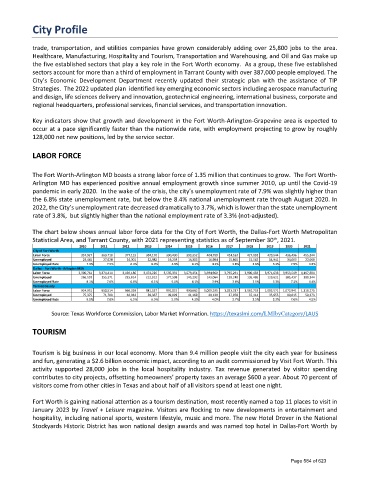Page 584 - FortWorthFY23AdoptedBudget
P. 584
City Profile
trade, transportation, and utilities companies have grown considerably adding over 25,800 jobs to the area.
Healthcare, Manufacturing, Hospitality and Tourism, Transportation and Warehousing, and Oil and Gas make up
the five established sectors that play a key role in the Fort Worth economy. As a group, these five established
sectors account for more than a third of employment in Tarrant County with over 387,000 people employed. The
City’s Economic Development Department recently updated their strategic plan with the assistance of TIP
Strategies. The 2022 updated plan identified key emerging economic sectors including aerospace manufacturing
and design, life sciences delivery and innovation, geotechnical engineering, international business, corporate and
regional headquarters, professional services, financial services, and transportation innovation.
Key indicators show that growth and development in the Fort Worth-Arlington-Grapevine area is expected to
occur at a pace significantly faster than the nationwide rate, with employment projecting to grow by roughly
128,000 net new positions, led by the service sector.
LABOR FORCE
The Fort Worth-Arlington MD boasts a strong labor force of 1.35 million that continues to grow. The Fort Worth-
Arlington MD has experienced positive annual employment growth since summer 2010, up until the Covid-19
pandemic in early 2020. In the wake of the crisis, the city’s unemployment rate of 7.9% was slightly higher than
the 6.8% state unemployment rate, but below the 8.4% national unemployment rate through August 2020. In
2022, the City’s unemployment rate decreased dramatically to 3.7%, which is lower than the state unemployment
rate of 3.8%, but slightly higher than the national employment rate of 3.3% (not-adjusted).
The chart below shows annual labor force data for the City of Fort Worth, the Dallas-Fort Worth Metropolitan
th
Statistical Area, and Tarrant County, with 2021 representing statistics as of September 30 , 2021.
2010 2011 2012 2013 2014 2015 2016 2017 2018 2019 2020 2021
City of Fort Worth
Labor Force 357,927 369,718 377,123 384,170 390,430 393,352 404,789 414,163 427,892 439,544 436,496 455,244
Unemployed 28,441 27,628 24,301 22,982 19,258 16,303 16,984 15,865 15,562 14,941 34,063 22,008
Unemployed Rate 7.9% 7.5% 6.4% 6.0% 4.9% 4.1% 4.2% 3.8% 3.6% 3.4% 7.9% 4.8%
Dallas - Fort Worth - Arlington MSA
Labor Force 3,300,761 3,374,414 3,420,186 3,474,226 3,535,331 3,579,454 3,694,960 3,795,291 3,900,458 3,971,633 3,953,549 4,107,884
Unemployed 266,593 255,271 225,014 212,012 177,598 145,292 143,064 138,248 136,486 129,621 285,437 180,344
Unemployed Rate 8.1% 7.6% 6.6% 6.1% 5.0% 4.1% 3.9% 3.6% 3.5% 3.3% 7.3% 4.4%
Tarrant County
Labor Force 924,951 950,514 966,259 981,537 991,015 990,682 1,009,291 1,033,317 1,062,733 1,082,571 1,072,941 1,110,275
Unemployed 75,375 71,788 62,944 59,367 49,829 41,169 40,130 37,978 37,114 35,655 80,815 50,373
Unemployed Rate 8.1% 7.6% 6.5% 6.5% 5.0% 4.2% 4.0% 3.7% 3.5% 3.3% 7.6% 4.5%
Source: Texas Workforce Commission, Labor Market Information. https://texaslmi.com/LMIbyCategory/LAUS
TOURISM
Tourism is big business in our local economy. More than 9.4 million people visit the city each year for business
and fun, generating a $2.6 billion economic impact, according to an audit commissioned by Visit Fort Worth. This
activity supported 28,000 jobs in the local hospitality industry. Tax revenue generated by visitor spending
contributes to city projects, offsetting homeowners’ property taxes an average $600 a year. About 70 percent of
visitors come from other cities in Texas and about half of all visitors spend at least one night.
Fort Worth is gaining national attention as a tourism destination, most recently named a top 11 places to visit in
January 2023 by Travel + Leisure magazine. Visitors are flocking to new developments in entertainment and
hospitality, including national sports, western lifestyle, music and more. The new Hotel Drover in the National
Stockyards Historic District has won national design awards and was named top hotel in Dallas-Fort Worth by
Page 584 of 623

